
A human rights network of 60 organizations working along the U.S.-Mexico border released a letter to Congress on Wednesday urging them to investigate “shadow police units” that have helped cover up beatings and killings by Border Patrol agents for more than three decades. The shadow units, identified in the letter as “Border Patrol Critical Incident Teams,” are said to possibly be “the largest and longest standing shadow police unit that is operating today in the federal government.” New details came to light when attorneys investigating the 2010 Border Patrol killing of Mexican father Anastasio Hernández Rojas found a secretive special investigative unit tampered with and even destroyed evidence in the case to shield the agents involved. Investigative journalist John Carlos Frey, who reported on the case and helped uncover the shadow groups, says agents “tampered with evidence, they obstructed justice, and they violated the law,” adding that Border Patrol is being permitted to “investigate itself without any oversight.”
Transcript
AMY GOODMAN: This is Democracy Now!, democracynow.org, The War and Peace Report. I’m Amy Goodman.
Human rights advocates are calling on Congress to investigate how “shadow police units” along the U.S.-Mexico border have helped cover up beatings and murders by Border Patrol agents for more than three decades.
New details came to light when attorneys investigating the 2010 Border Patrol killing of Mexican father Anastasio Hernández Rojas found a secretive special investigative unit tampered with and even destroyed evidence in the case to shield the agents involved. Rojas was beaten and shocked to death by the agents after he tried to cross the border to return to San Diego, California, where he had lived for 25 years, to be with his five children. Rojas lay on the ground handcuffed at the San Ysidro Port of Entry as agents beat him with batons and shocked him with a stun gun. He died at the hospital several days later. The San Diego Coroner’s Office classified Anastasio’s death as a homicide, concluding he suffered a heart attack, as well as, quote, “bruising to his chest, stomach, hips, knees, back, lips, head and eyelids, five broken ribs, and a damaged spine.”
After the assault, Border Patrol never notified San Diego police of the incident. Instead, it’s now clear that it had its own Critical Incident Team — that’s CIT — control witness lists, remove language in a report that described Rojas as being compliant during his arrest. Agents were also at the hospital directing doctors who treated Rojas before he died.
Democracy Now! spoke with Anastasio Hernández Rojas’s brother Bernardo in 2016.
BERNARDO HERNÁNDEZ ROJAS: [translated] Anastasio was murdered, he was tortured, on the 28th of May, 2010. Five years have elapsed, and we’ve not found justice. During these five years, we have been fighting for justice, and they have not paid attention to us. … During these five years, we have also met other people who have gone through the same thing, and many very similar things continue to happen at the border. We want this to stop. We want them to stop these injustices. And we want a response from the government as to what’s happening with my brother’s case and why have they not responded with good news.
AMY GOODMAN: With the new details in this case and others now brought to light, on Thursday the Southern Border Communities Coalition sent a letter to Congress to, quote, “sound the alarm on the dangerous overreach of the illegal operation of U.S. Border Patrol’s unlawful Critical Incident Teams.”
For more, we’re joined in Los Angeles by award-winning investigative journalist John Carlos Frey, who’s reported extensively on human rights abuses at the U.S.-Mexico border, author of Sand and Blood: America’s Stealth War on the Mexico Border.
Welcome back to Democracy Now! Can you talk about the case we just went through, in light of the new information that you’re uncovering about these shadow police units within U.S. Border Patrol?
JOHN CARLOS FREY: Yes, of course. It’s good to be with you, Amy. And, you know, I’ve been doing this for a long time, and it is shocking.
Within the actual agency of the U.S. Border Patrol, there is an investigative body called CIT, the Critical Incident Team. They are tasked with investigating incidents that involve Border Patrol, and it can be anything from a car accident to, in this case, an individual who’s killed at the hands of the U.S. Border Patrol.
In this particular case of Anastasio Hernández Rojas, Border Patrol agents deleted video. They collected evidence at the scene. They were present in the hospital when Anastasio was being treated. They were present at the autopsy. They fudged reports. They deleted reports. They coached their own agents on what kind of testimony they were to give. They were present at every one of the depositions. They made sure that they were the victims in this case. And when I say that, what I mean is that Border Patrol agents — CIT team agents make sure that Border Patrol agents are looked at as the victims in any sort of an incident, meaning that they are allowed then to use lethal force, if a Border Patrol agent has rocks thrown at them or, in the case of Anastasio, they allege that Anastasio was violent and that he was kicking and punching, and he needed to be subdued. If we take a look at the videotape, that’s not actually what happened. He’s handcuffed. He’s prone on the ground. His face is down. Agents are on top of him. But if you read the reports in this case that were prepared by CIT, Anastasio was a violent man and needed to be subdued.
So, anywhere from the beginning of the investigation to the end of the investigation, CIT team members tampered with evidence, they obstructed justice, and they violated the law, not just because of what they did with the actual evidence in the case, but they don’t even have an authority to exist. There is not a police agency, whether it’s a municipal police agency or a federal police agency, that gets to investigate itself without any oversight. And that’s what the Border Patrol is doing right now.
AMY GOODMAN: So, talk about what has been uncovered and what exactly the group on the border — the letter that has been sent to Congress.
JOHN CARLOS FREY: Yeah. I was actually — you know, it’s something that a reporter doesn’t usually do — working with nongovernmental organizations like the Southern Border Communities Coalition, but I had handed them evidence, because they would like to get a congressional hearing off the ground.
One of the pieces of evidence that I had uncovered was a PowerPoint presentation that was actually produced by the U.S. Border Patrol about these secret police agencies or investigative bodies within the Border Patrol. And in that PowerPoint, prepared by the Border Patrol, it’s very specific as to what these CIT team members are supposed to be doing at an incident or where a Border Patrol agent is involved. They are there to “mitigate” litigation. That is a quote. Border Patrol agents who investigate an incident are there to mitigate litigation. They’re not there to collect evidence. They’re not there to make sure that they are looking at the facts. But they’re there to make sure that Border Patrol agents are not prosecuted. That’s one of their primary goals.
They’re also there, as I said earlier, to make sure that Border Patrol agents look like they were the ones that were accosted or that they themselves are the victims, so that any use of force is warranted. They are there to make sure that Border Patrol get the right spin and make sure that they get their message out properly. This is in the PowerPoint presentation prepared by Border Patrol. Their own critical investigative teams are there to mitigate any sort of liability that makes the Border Patrol look bad or brings any kind of charges against them. So, I’m not sure how objective they are out in the field. And as we were talking about in the case of Anastasio, it is rife with corruption.
AMY GOODMAN: I want to go to the case of 16-year-old José Antonio Elena Rodríguez, who was killed in Nogales, Mexico, by U.S. Border Patrol agent Lonnie Swartz, who fired his gun from the U.S. side of the border through the wall. The teenager, who was unarmed, died face-down on the sidewalk just a couple of blocks from his home. After nearly five years of legal delays, José Antonio’s mother, Araceli Rodríguez, and his grandmother brought Swartz to trial for second-degree murder in 2017. A Tucson, Arizona, jury acquitted him and were deadlocked on manslaughter charges. In a second trial in 2018, Swartz was found not guilty of involuntary manslaughter. During the court proceedings, it was revealed a local Border Patrol special investigative unit had collected all the evidence for the FBI. We were with José Antonio’s mother, Araceli, in Nogales in 2019, in Sonora, at the site where her son was murdered.
AMY GOODMAN: The Border Patrol agent said he feared for his life. He would have been standing, oh, 30 feet above your son walking here on the sidewalk. Can you respond to the agent saying he feared for his life?
ARACELI RODRÍGUEZ: [translated] That Lonnie Swartz lied the whole time. He tried to defend something indefensible. There was a video, because there’s a camera right there. There was a video that was allegedly lost where it showed Lonnie Swartz murdering my son. What he says about his life being in danger is not true. Everyone who comes here and sees the height of this wall realizes that Lonnie Swartz was lying about my son throwing rocks. His own co-workers at the trial said that his life was not in danger, that he could have stepped away. It was never proven that José Antonio was throwing rocks.
AMY GOODMAN: And there is Antonio’s mother, Araceli, in Nogales, Sonora, in 2019 at the site where her son was murdered. She’s standing right in front of a picture of her son, as we investigated this case at the time. John Carlos Frey, this case, among others, is referenced in the letter to Congress. Can you talk about the information that came out around the CIT units and what they did in covering this up?
JOHN CARLOS FREY: It is a very disturbing case and a very disturbing trend here — a 15-year-old boy shot in the back, unarmed, standing in Mexico, while the U.S. Border Patrol agent is standing in the United States, found not guilty, basically.
Lonnie Swartz is the only Border Patrol agent prosecuted for misfiring his weapon in the entire history of the U.S. Border Patrol. That’s the only person who’s been prosecuted. There were a couple of other agents who were prosecuted in Texas during the Bush administration for firing their weapon at a drug dealer — they hit him in the back — but this is the first time in U.S. Border Patrol history that anybody has been prosecuted for the death of an individual. In the past 15 years, over a hundred individuals have been killed at the hands of the U.S. Border Patrol at the border, and not one of them has been brought to prosecution.
That is what CIT is doing. They are preparing evidence. They are doctoring evidence. They are tampering with evidence. They are deleting evidence. They are making sure that agents themselves look like they are firing their weapons properly, that everything they do is on the up and up, and there’s nothing to see here.
In the case that we’re talking about, there was an unarmed boy who was shot in the back. There were two surveillance video cameras that are anchored right on the top of the border fence. They’re pointed right where the incident occurred. That video is missing. We don’t know what happened to it, because CIT prepared the investigation. The Border Patrol prepared that investigation. So, you know, if we’re talking about making sure that they defend themselves against civil liability, well, of course, they’re going to delete that video.
AMY GOODMAN: John Carlos Frey, we want to thank you for being with us, award-winning investigative journalist, reported extensively on immigration, author of the book Sand and Blood: America’s Stealth War on the Mexico Border.
Coming up, what does the late great Nobel Prize-winning novelist Toni Morrison have to do with the Virginia governor’s race? Stay with us.

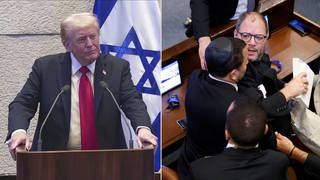
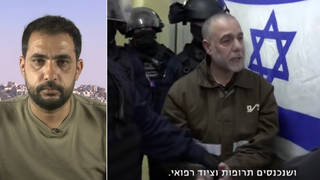
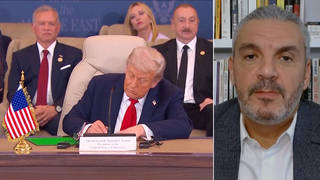
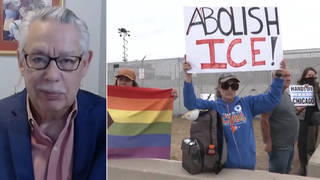



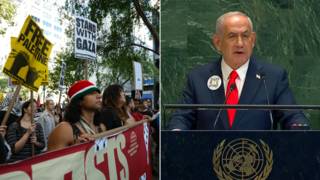

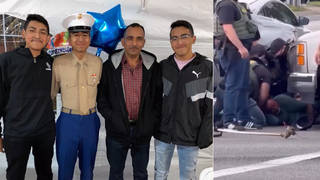
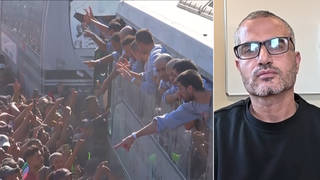
Media Options